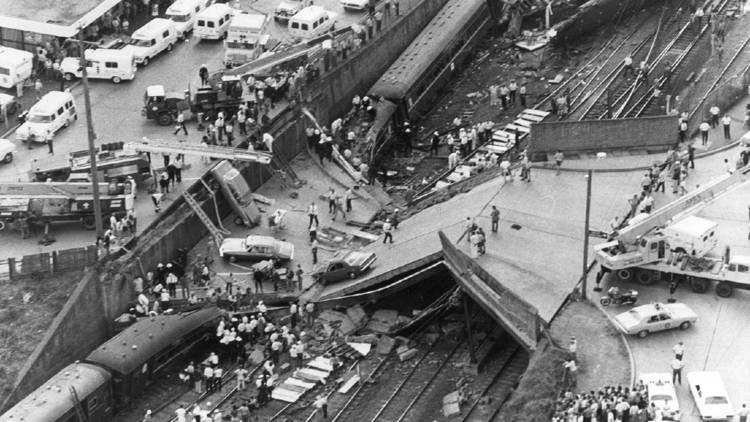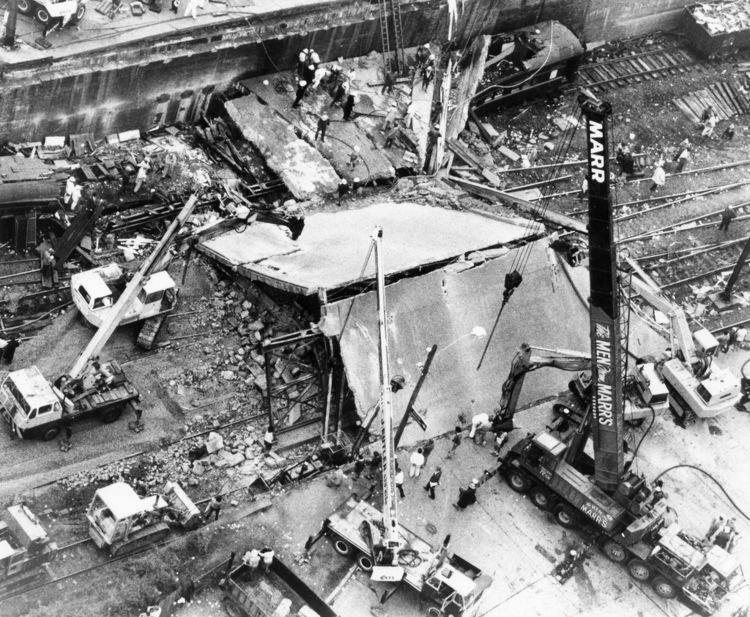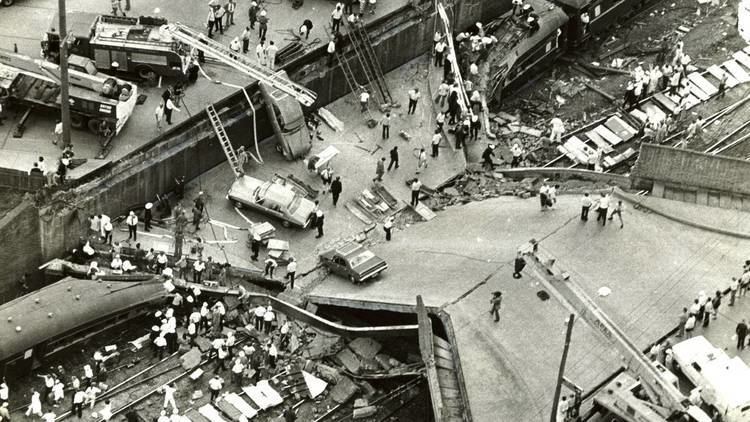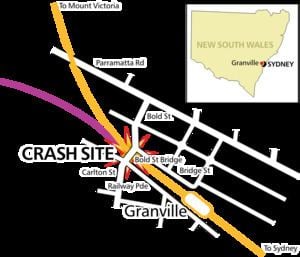Time 08:10 Type of incident Derailment Date 18 January 1977 Trains 1 Injuries 213 | Country Australia Cause Poor track condition Total number of deaths 84 | |
 | ||
Similar Waterfall rail accident, Glenbrook rail accident, 1997 Thredbo landslide, Southall rail crash, 1989 Newcastle earthquake | ||
Granville rail disaster january 18th 1977
The Granville rail disaster occurred on Tuesday 18 January 1977 at Granville, a western suburb of Sydney, Australia, when a crowded commuter train derailed, running into the supports of a road bridge that collapsed onto two of the train's passenger carriages. It is the worst rail disaster in Australian history: 84 people died, more than 210 were injured, and 1,300 were affected.
Contents
- Granville rail disaster january 18th 1977
- Sydney trains vlog 1374 granville rail disaster scene
- Crash
- Aftermath
- Memorial trust
- In media
- Similar rail accidents
- References

Sydney trains vlog 1374 granville rail disaster scene
Crash

The crowded Sydney-bound eight carriage commuter train, having left Mount Victoria in the Blue Mountains at 6:09am, was hauled by a New South Wales 46 class locomotive, No. 4620. It was approaching Granville railway station when it left the rails at approximately 08:10am and hit a row of supports of the overhead Bold Street bridge, which were constructed of steel and concrete.

The derailed engine and first two carriages passed the bridge. The first carriage broke free from the other carriages. Carriage one was torn open when it collided with a severed mast beside the track, killing eight passengers. The remaining carriages ground to a halt with the second carriage clear of the bridge. The rear half of the third carriage, and forward half of the fourth carriage, came to rest under the weakened bridge, whose weight was estimated at 570 tonnes (560 long tons; 630 short tons). Within seconds, with all its supports demolished, the bridge and several motor cars on top of it crashed onto the carriages, crushing them and the passengers inside.

Of the total number of passengers travelling in the third and fourth carriages, half were killed instantly when the bridge collapsed on them, crushing them in their seats. Several injured passengers were trapped in the train for hours after the accident, with part of the bridge crushing a limb or torso. Some had been conscious and lucid, talking to rescuers, but died of crush syndrome soon after the weight was removed from their bodies. This resulted in changes to rescue procedures for these kinds of accidents. Rescuers also faced greater difficulties as the weight of the bridge was still crushing the affected carriages, reducing the space in which they had to work to get survivors out, until it was declared that no one was allowed to attempt further entry until the bridge had been lifted. That the bridge split while being lifted and collapsed back onto the train did not make things any easier.

Another danger came from gas; large gas cylinders were kept year-round on board the train to be used in winter for heating. Several people were overcome by gas leaking from ruptured cylinders. The leaking gas also prevented the immediate use of powered rescue tools. The NSW Fire Brigade provided ventilation equipment to dispel the gas and a constant film of water was sprayed over the accident site to prevent the possibility of the gas igniting.
The train driver, the assistant crewman, the "second man", and the motorists driving on the fallen bridge all survived. The operation lasted from 8:12am Tuesday until 6:00am Thursday. Ultimately, 83 people were killed in the accident.
Aftermath

The bridge was rebuilt as a single span without any intermediate support piers. Other bridges similar to the destroyed bridge had their piers reinforced.
The inquiry into the accident found that the primary cause of the crash was "the very unsatisfactory condition of the permanent way", being the poor fastening of the track, causing the track to spread and allowing the left front wheel of the locomotive to come off the rail. How this happened was related to a high turnover of staff combined with a lack of standard procedures for track inspections. The posted speed limit for the track was not shown to be excessive, provided appropriate track inspection and maintenance was occurring.
Other contributing factors included the structure of the bridge itself. When built, it was found to be one metre lower than the road. Concrete was added on top to build the surface up level with the road. This additional weight significantly added to the destruction of the wooden train carriages. The disaster caused substantial increases in rail-maintenance expenditure. The train driver, Edward Olencewicz, was exonerated by the inquiry.
Memorial trust
The Granville Memorial Trust was established after the accident to commemorate the victims and campaign for improvements to rail safety.
The Trust organises an annual memorial service on the anniversary of the crash. Families and friends of the victims gather with surviving members of the rescue crews in a march through Granville to the Bold Street bridge where the accident occurred. The ceremony ends with the throwing of 83 roses on to the tracks to mark the number of passengers killed. In 2007, a plaque was placed atop the bridge to mark the efforts of railway workers who assisted in rescuing survivors from the train.
Trust members also make submissions on rail safety issues, including recommending that fines for safety breaches be dedicated to rail safety improvements, and campaigning for the establishment of an independent railway safety ombudsman.
